- Author: Vicky Boyd
- Author: Rachael Long
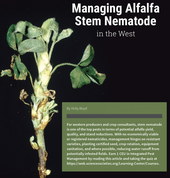
This is a great article on Stem Nematode management in the West. Stem Nematode has been a severe pest in some years throughout California's Central Valley and high mountain valleys.
Stem nematode causes severe stunting, shortened internodes, and low first cut yields and can cause severe stand loss if infections are high. It's transferred by irrigation water and equipment. It is typically seen in very late winter or early spring.
Article by Ag Writer Vicky Boyd, in the Crops and Soils Magazine, available at:
- Author: Sarah E Light
- Author: Rachael Long
- Contributor: Taiyu Guan
- Contributor: Clair Akin
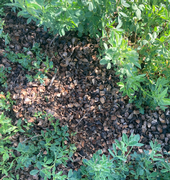
Background of the Project
Recent regulations, incentive funding, and the state's goal of reducing organic matter into the waste stream has led to increased organic matter application to California Farmland. With increasing limitations on burning orchard by-products, some alfalfa growers have been applying almond shell mulch to their fields.
Almond shells are distinct from almond hulls, which are high in carbohydrates and fed widely to livestock. Unlike hulls (which are more similar to dried peaches), shells are woody and break down more slowly. Almond shells are high in carbon and low in nitrogen (N).
- Author: Roger A Baldwin
- Author: Niamh Quinn
- Author: Daniel H. Putnam
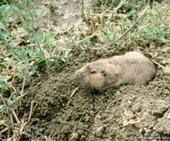
PROPOSED LABEL CHANGES
The US EPA has proposed a series of dramatic changes to rodenticide labels which will significantly change how rodenticides are used in alfalfa, pasture, and many other crops (orchardes, vineyards).
Among other restrictions,
- All rodenticides for field applications will be restricted-use (new requirements for equipment, training)
- Above-ground applications eliminated
- Author: Michael Rethwisch
- Author: Ian M Grettenberger
- Author: Daniel H. Putnam
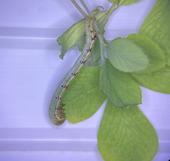
A new caterpillar was found this fall on alfalfa in the Palo Verde Valley of California and several other alfalfa growing areas of western Arizona.
Is this a New Pest? The initial finding of the ‘dot-lined angle' caterpillar (moth) was reported to UCCE in mid-October by a highly experienced pest control advisor (Richard Wellman), who had collected it in several fields in the Palo Verde Valley but realized it was an unfamiliar species. UCCE advisor Michael Rethwisch (Riverside County, CA) identified the species as the dot-lined angle (Psamatodes abydata), with this identification confirmed by Marc Epstein at the California Department of Food and...
- Author: Rachael Freeman Long
- Author: Morgan Doran
- Author: Robert Poppenga
- Author: Dan Putnam
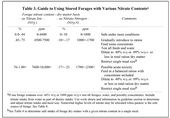
Sudangrass (Sorghum bicolor L.) is a type of sorghum which is widely grown for hay, greenchop or grazing systems. Typically over 50,000 acres of sudangrass are grown for hay in the Imperial Valley of California, much of it exported to Japan.
However, sudangrass (and sudan-sorghum hybrids) can be grazed or fed as greenchop to livestock particularly beef animals or used as a vigorous cover crop. What are the risks of feeding sudangrass to livestock?
Is Grazing Safe? A couple of questions have come up about grazing sudangrass including: 1) grazing sudangrass stubble after harvest, and 2) grazing sudangrass in a cover crop. Is this a safe practice? Maybe, but pay attention! Care is...



